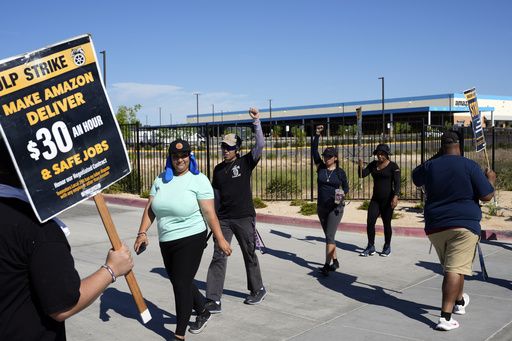Teamsters add their heft to dozens of Amazon delivery drivers picketing around the country
Workers picket outside an Amazon distribution center on Monday, July 24, 2023, in Palmdale, Calif. Dozens of Amazon drivers and dispatchers who work for a California-based delivery firm the Teamsters unionized in April have been picketing company warehouses, calling on the e-commerce behemoth to come to the table and bargain over pay and working conditions. (AP Photo/Marcio Jose Sanchez)
NEW YORK (AP) — The Teamsters flexed their muscles during contract negotiations with UPS last month, securing pay hikes for drivers and scoring other wins.
But at Amazon, the picture looks much different.
Since late June, dozens of Amazon drivers and dispatchers who work for a California-based delivery firm that the Teamsters unionized in April have been picketing company warehouses as far out as Michigan and Massachusetts, calling on the e-commerce behemoth to come to the table and bargain over pay and working conditions.
Amazon has essentially said no. Teamsters say the strike will continue until Amazon reinstates the employees and comes to the bargaining table.
Though small, the dispute in California signals what’s poised to be the next battlefront in Amazon’s efforts to fend off organized labor and the Teamsters’ years-long aim to take on one of their most formidable opponents.
During speeches and interviews in recent months, Teamsters General President Sean O’Brien has aired his belief that a strong UPS contract would also bolster the union’s organizing prospects at Amazon, where the sole labor group — made up of current and former warehouse workers who won a union election last year — is still without a contract amid objections and appeals from the company.
“Workers at Amazon are paying attention to the workers at UPS right now,” said Randy Korgan, who was appointed by O’Brien last year to lead the union’s recently launched Amazon division. “These are similar workers that look just like them — doing very similar work to what they’re doing.”
The set-up at Amazon, however, is much different. Though the delivery drivers are clothed in the ubiquitous gray-blue Amazon vests and drive similarly colored vans, they’re not directly employed by the company. Instead, they work for the more than 3,000 delivery service partners, or DSPs, that Amazon has recruited to drop off packages to customers.
Amazon’s business model originally relied heavily on other carriers, including UPS and the U.S. Postal Service where unions had major sway on pay and working conditions. But in the past few years, it has been reducing its dependence on other shippers and expanding its own logistics capability.
Most Amazon shipments these days go through the company’s own last-mile network, the final leg of a delivery that relies on DSPs that handle more than 10 million Amazon packages everyday. Outsourcing the work allows Amazon to eschew financial and legal liability that might come from directly employing hundreds of thousands of drivers. It also gives the retailer more cover from unionization attempts since the workers aren’t classified as Amazon employees under existing labor law.
The Teamsters are seeking to challenge that in California. In a complaint filed in May with the National Labor Relations Board, the union argued Amazon should be considered a single or joint employer with Battle Tested Strategies, a DSP that employs more than 80 delivery drivers and dispatchers. The Teamsters maintain that Battle Tested Strategies belongs to a system that’s “owned and controlled” by Amazon.
Amazon claims the union is spreading a false narrative about how its business works. The company also said that it terminated Battle Tested Strategies even before its workers unionized, accusing it of six breaches of contract, including failing to pay for insurance. Battle Tested Strategies — one of many DSPs that operate in California — stopped delivering for Amazon in late June.
Johnathon Ervin, an Air Force veteran who owns Battle Tested Strategies, said he applied for Amazon’s delivery program in 2018 and launched his business the next year after months of training. Initially, he got five vans from the company and began deliveries in El Monte, a city in Los Angeles roughly 60 miles south of Palmdale, where the firm is located.
Ervin said it was exciting at first, but it soon became challenging as his business grew and costs crept up for vehicle maintenance, insurance and other things like overtime pay during peak seasons. Amazon gives delivery firms a pot of money to cover expenses for every route they’re given, but he said it didn’t cover everything, like all overtime expenses for workers.
Figuring out how to be profitable also became a headache. The company installs devices in vans that monitor drivers’ habits, and issues a weekly scorecard rating their performance on things like delivery completion from a scale from poor to “fantastic plus.” Those ratings determine how much DSPs make per package, but Ervin said the way Amazon assess drivers and the way delivery firms do might not always line up.
“It’s a really insidiously data driven-control that they use to manipulate and move folks in the direction that they want them to go,” he said.
Amazon spokesperson Mary Kate Paradis countered DSP rates vary by location across the country and the vast majority or those surveyed “say they’re within or above the projected profitability range of $75,000 and $300,000 per year.” In response to Ervin’s claims about failing to pay for overtime expenses, Paradis said DSPs are responsible for paying their employees.
The Teamsters seem to be taking a long-term approach to organizing at Amazon. In the past few years, the union has been pushing back on Amazon projects in local communities and questioning the company’s federal contracts, among other things.
John Logan, director of labor and employment studies at San Francisco State University, said focusing on subcontractors is also a good starting point for the Teamsters because its easier to organize those firms compared to larger Amazon warehouses.
But he also noted the union’s campaign still seems somewhat underdeveloped because it’s been focused on getting a good contract at UPS. The Teamsters’ only other Amazon union victory was short-lived: In 2017, delivery drivers in Michigan who worked at a company that contracts with Amazon voted to organize. But Amazon dissolved their contract shortly thereafter.
“Amongst other groups and younger people in the labor movement… they are very enthusiastic about the idea about not only organizing Amazon, but that there’s a very powerful union that’s prepared to put resources into that,” Logan said. “But it hasn’t happened yet. So we don’t really know.”
Copyright 2023 The Associated Press. All rights reserved


